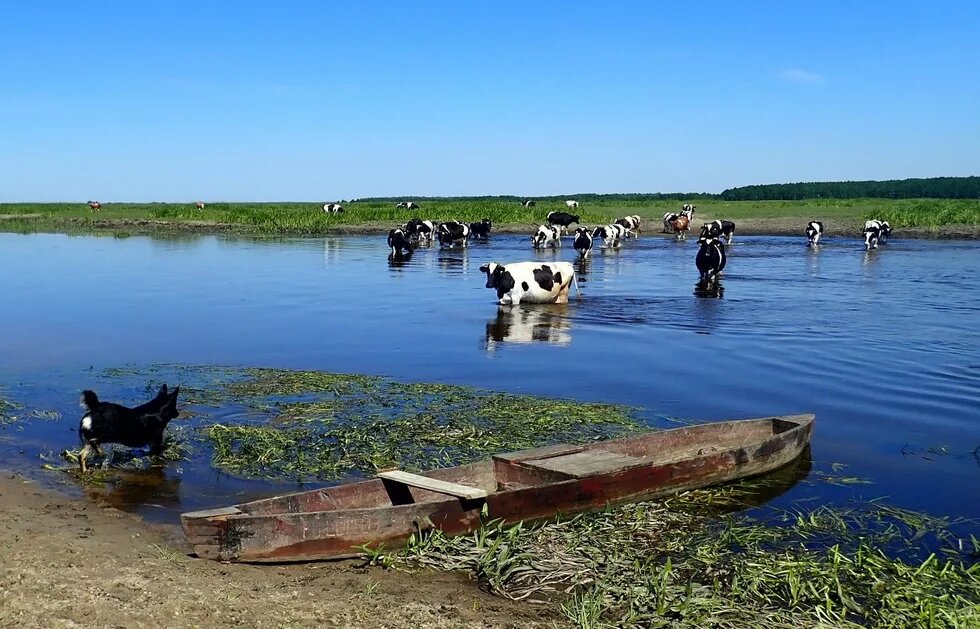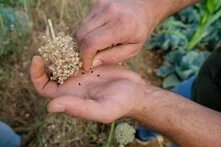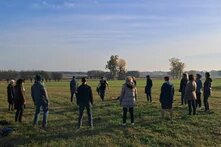Traditional farming and the knowledge of local communities have played a significant historical role in the development of high nature value ecosystems in Europe. Therefore, an agroecological approach to the conservation of biodiversity in agricultural landscapes should draw on both scientific and local traditional knowledge. This article focuses on ethnoecological research into changes in the hay management regime in the extensive wetlands of Biebrza National Park in Poland.

The European landscape and its habitats are shaped by the enormous impact of agriculture, which has been present in the area for several thousand years1. Traditional farming2 practices have historically contributed to the development of semi-natural habitats replacing forest ecosystems in the temperate climate of Central Europe. In other words, human agricultural activity has shaped the dominant biocultural landscape in Europe, with many high nature value habitats shaped by anthropogenic disturbance. Such habitats include meadows, pastures and semi-open woods historically grazed and extensively used. Interestingly, they have increased the mosaic of the agricultural landscape and amplified its biodiversity. As recently as the 1990s, it was estimated that more than half of the most valuable ecosystems in Europe occur in farmlands.
European Agricultural Policy disadvantaged traditional farming
At the same time, the need for urgent conservation of these habitats has been highlighted. It has been proposed that support for the extensive agriculture that maintains high value habitats be included in the political agenda. It has been noted that traditional farming is threatened by intensive agriculture, which is developing at its expense. Likewise traditional farming-dependent habitats might be lost due to the degrading influence of farming intensification or abandonment caused by their low productivity. Indeed, under the Common Agricultural Policy (CAP), specific schemes have been designed (agri-environmental and agri-environmental-climate schemes, referred to here as AESs) to financially support farmers in the use of biodiverse semi-natural habitats. However, the system has lacked the tools to effectively support traditional farming. For instance, in Poland, during the first 16 years after it joined the European Union in 2004, ca. 0.5 million traditional family farms have collapsed. Many authors indicate that it was the CAP subsidy system that significantly accelerated this process.
In agroecology, traditional knowledge is a foundation that is equivalent to scientific knowledge.
It is still rare that conservationists and agricultural policy designers recognise and acknowledge the entire nature of semi-natural ecosystems, whose biodiversity is largely influenced by historical agricultural practices embedded in local contexts. The reason for this is most likely a lack of interdisciplinarity in nature conservation, and a still dominant ‘hands off’ approach (minimising human intervention in the ecosystem). This strategy is often intended to facilitate the management of nature protection in an area, but in essence it stems from the prevailing perception, shared by the general public, of humans as devastators of nature.
There is also a deeply rooted belief among policymakers, academia and civil society in the superiority of scientific knowledge over the knowledge of local land stewards and farming practitioners. Even though farmers and their ancestors are the people behind historically traditional farming that has maintained valuable semi-natural habitats for hundreds of years, in the current system they remain only passive recipients of nature conservation policy. Their knowledge is frequently unrecognized and unacknowledged by conservationists and policymakers in Europe. While the Intergovernmental Science-Policy Platform on Biodiversity and Ecosystem Services (IPBES) indicated several years ago the crucial role of the traditional ecological knowledge (TEK) of local communities in biodiversity maintenance has been identified by ethnoecologists studying the relationship between humans and nature, including among European farming communities.
Traditional ecological knowledge stems from direct, everyday contact with nature, observations made during hand farming work, and multigenerational life in a given area. Even if TEK already belongs to history in contemporary rural societies, its heritage should be recognised and efforts should be made to get to know this knowledge as much as possible. In agroecology, traditional knowledge is a foundation that is equivalent to scientific knowledge.
Why traditional knowledge is needed to conserve wetlands
The problem of protecting semi-natural habitats in the context of changes in traditional farming, the impact of the CAP, and the importance of TEK and agroecology are illustrated by research conducted between 2017 and 2020 in the Biebrza National Park. The Biebrza Valley floodplain, located in north-east Poland, belongs to one of the largest wetland ecosystems in Central Europe. It is estimated that permanent settlements have been present in this area for several hundred years. During this time, the local community have managed wetlands under a traditional mowing and grazing regime for their subsistence.
About half a century ago, wetland management began to change due to an intensification in farming and access to more productive meadows outside the valley. Wetland use gradually ceased, which led to secondary succession and shrub encroachment. Until now this has been considered the main threat to the biodiversity of these semi-natural ecosystems. Since the establishment of the Biebrza National Park in 1993, efforts have been made to counteract succession. Additionally, it was hoped that the AES subsidy system would motivate farmers to reintroduce wetland management. In this context, extensive mainly interview-based ethnoecological research among the local community was conducted.
Research showed a significant degradation of traditional ecological knowledge among the younger generation.
Traditional farming has been present in this area since the 1990s, which increased the likelihood of TEK among the currently studied local community. Additionally, given that CAP was already in place for over a decade, the study aimed to find out how AESs shaped the wetland management and whether they supported extensive agriculture, as they initially intended. The research showed a significant degradation of traditional ecological knowledge among the younger generation, in contrast to older farmers, who still had a deep knowledge. TEK covered local toponyms, as well as knowledge of the landscape and vegetation managed according on its fodder suitability. By applying their own taxonomy, respondents identified over 50 ethnospecies of wetland plants, extensively described by their morphology and habitat, and observed changes in occurrence and fodder attractiveness. Details of the traditional year-round wetland management regime were reconstructed.
Current agricultural management was compared with traditional use by practices that have a significant impact on wetland biodiversity, including the presence of grazing, the frequency and timing of mowing, mowing tools, the form of hay harvesting, usage of hay, and application of mineral fertilisers. It turned out that traditional agriculture was not really a reference point for the management implemented under AESs. Some AESs were defined under target bird species and mainly differed by mowing time, which depends on these birds’ nesting periods. Other AESs aimed at habitat protection were also defined according to general scientific knowledge.
Interestingly, the second most frequently implemented AES designed to protect a rare bird species, the aquatic warbler, required very late mowing compared to traditional mowing, which in turn required the use of heavy equipment on wetlands, ultimately destroying the unique sedge tussock structure preferred by this bird. However, the most frequently implemented AES (designed for the protection of another group of birds) was one of the few that met farmers’ agricultural needs by allowing for the early mowing of hay, which could be used as fodder. Unfortunately, none of the AESs required obligatory grazing, therefore farmers in the study ceased cattle grazing in favour of conventional indoor livestock farming. The complete abandonment of animal husbandry in favour of generating income solely from AESs was also observed.
An agroecological approach would acknowledge the role of farmer-practitioners
The study revealed the presence of traditional knowledge among the local community, which several decades ago may have been an even richer source of information about the local ecosystem and its management. Instead of supporting extensive farming, agricultural policy measures contributed to the abandonment or intensification of animal husbandry3. Despite the reimplementation of wetland use and an increase in the population of protected birds, AESs still raise concerns. The lack of grazing, late mowing dates adjusted to several target bird species, widespread mechanised mowing, and biomass harvesting call into question the effective conservation of wetland habitats as well as plants, invertebrates, amphibians and small mammals that inhabit them. As wetlands were the first grazed ecosystems in Europe, there has been a long history of adaptation of wetland plants to extensive grazing, which maintains them and plays a key role in the enhancement of biodiversity.
It can be concluded that the environmental objective is the main focus in AES design, while the schemes are not an effective tool in the support of traditional agriculture. Moreover, traditional farming and TEK do not serve as a reference for AESs. The schemes are defined top-down on the national level, without regard for local specifics. Effective conservation would require an openness to interdisciplinary cooperation and an agroecological approach that acknowledges the role of farmer-practitioners and the value of traditional ecological knowledge. If not from living knowledge-holders, it can be sourced from ethnographic and historical literature.
References:
Biró M, Molnár Z, Babai D, Dénes A, Fehér A, Barta S, Sáfián L, Szabados K, Kiš A, Demeter L, Öllerer K. Reviewing historical traditional knowledge for innovative conservation management: A re-evaluation of wetland grazing. Science of The Total Environment. Vol.666. doi:10.1016/j.scitotenv.2019.02.292
Bobiec A, Rotherham I.D, Kırca S, Molnár Z, Agnoletti M. 2024. Towards biocultural realism: Connecting conservation with historical ecology and common sense. A European perspective. Ambio. 54(3), 505-519. doi:10.1007/s13280-024-02089-2
Molnár Z, Fernández-Llamazares A, Schunko Ch, Teixidor-Toneu I, Jarić I, Díaz-Reviriego I, Ivascu C, Babai D, Sáfián L, Karlsen P, Dai H, Hill R. 2023. Social justice for traditional knowledge holders will help conserve Europe's nature. Biological Conservation. 285(3):110190. doi:10.1016/j.biocon.2023.110190.
Poschlod P. 2015. The Origin and Development of the Central European Man-made Landscape, Habitat and Species Diversity as Affected by Climate and its Changes – a Review. Interdisciplinaria Archaeologica – Natural Sciences in Archaeology. VI(2/2015):197-221. doi:10.24916/iansa.2015.2.5
Sucholas J, Molnár Z, Łuczaj Ł, Luick R, Poschlod P. 2025. Are agri-environmental schemes doing their job? Evidence from Biebrza National Park, Poland. Land Use Policy J. 148(4). doi:10.1016/j.landusepol.2024.107390
Sucholas J, Molnár Z, Łuczaj Ł, Poschlod P. 2022. Local traditional ecological knowledge about hay management practices in wetlands of the Biebrza Valley, Poland. J Ethnobiol Ethnomed. 18(9):1–42. doi:10.1186/s13002-022-00509-9
Sutcliffe L, Batáry P, Kormann U, Báldi A, Dicks L V., Herzon I, Kleijn D, Tryjanowski P, Apostolova I, Arlettaz R, et al. 2015. Harnessing the biodiversity value of Central and Eastern European farmland. Divers Distrib. 21(6):722–730. doi:10.1111/ddi.12288.
Footnotes
- 1
The origin of agriculture in Central Europe is estimated to be around 5500 BC.
- 2
Traditional agriculture, unlike intensive agriculture, is characterised by low agrochemical and external fodder input, a low degree of mechanisation, the relatively high participation of semi-natural vegetation, and long-established farming practices, etc.
- 3
It should be noted though that AESs to some extent hinder the intensification of agriculture, e.g. by banning the application of fertilisers or preventing very early mowing.

